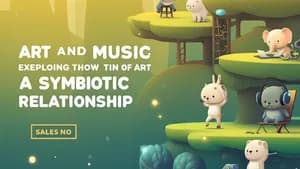Beyond the Spectrum: Exploring Color in Art and Music
Have you ever stopped to think about how color can make you feel? In a painting, a splash of bright yellow might evoke feelings of sunshine and joy, while a deep blue might stir a sense of peace and tranquility. But did you know that similar principles apply to music? Just like in art, the use of color in music can evoke specific emotions and create a powerful connection with the listener. In this article, we'll dive into the fascinating world of color in art and music, exploring how these two seemingly distinct disciplines share a hidden language that speaks to our senses and our souls.
The Language of Color in Art
In art, color theory is a fundamental tool that artists use to create visually appealing and expressive works. You've likely heard about primary colors, secondary colors, and tertiary colors, but did you know that there are also specific color relationships that can influence the mood and feeling of a piece? Think about a vibrant red against a cool blue – these complementary colors create a sense of visual tension and excitement. On the other hand, a harmonious palette of green and blue evokes a calming and serene atmosphere.
This is where it gets really interesting: these color relationships are not just visually appealing, but they also evoke distinct emotional responses. Think about a sunset, with its warm oranges and reds blending into a cool blue sky. It's no coincidence that this scene evokes a sense of tranquility and serenity. As a student, understanding the psychology of color in art can enhance your appreciation of visual works, allowing you to delve deeper into the artist's intention and the emotions they sought to convey.
Music's Color Palette
Just as color in art plays a key role in visual communication, music also has a hidden color palette that affects the way we experience sound. Think about a piece of classical music, where the composer uses various instruments, each with its unique timbre or sound quality. The combination of these sounds, just like the blending of colors in a painting, creates a sonic landscape with distinct emotional qualities.
For instance, a piece played on the flute might evoke a sense of lightness and airiness, much like the color yellow, while a deep cello tone might evoke feelings of melancholy and darkness, similar to the color blue. Even within the same instrument, different notes can have different color associations. A high note on the piano might sound bright and cheerful, akin to a vibrant red, while a low note might sound somber and heavy, much like the color black.
Bridging the Gap: Color and Music Theory
Now, let's explore how the language of color can be used to understand the principles of music theory. Just as artists use complementary colors to create visual tension and contrast, composers use complementary chords in music to create tonal tension and resolution. Think of a major chord, which is often associated with feelings of happiness and brightness, and a minor chord, which is often associated with feelings of sadness and darkness. These two chord types, similar to complementary colors, create a sense of musical tension that is ultimately resolved through the movement of the harmony.
This connection between color and music theory can be applied to understanding different musical concepts like scales, modes, and chord progressions. For example, the major scale, often associated with a bright and cheerful sound, can be visualized as a palette of vibrant colors, while the minor scale, often associated with a darker and more melancholy sound, can be visualized as a palette of muted colors.
Exploring Color and Music: Practical Activities
Now that you have a better understanding of the connection between color and music, you can start to explore it yourself. Here are some practical activities that you can try:
-
Visualize Your Favorite Music: As you listen to music, close your eyes and imagine the colors that the sound evokes. What colors do you see when a certain instrument plays? How do the colors change as the music progresses? This can help you develop a deeper understanding of the emotional impact of music. You might be surprised at the color palettes you create for your favorite songs!
-
Create a Music Color Wheel: Just like there is a color wheel in art, you can create a music color wheel by assigning specific colors to different notes, chords, and even musical styles. You can use colored markers, paints, or even digital tools to create your own visual representation of music. This can be a fun and engaging way to explore the relationship between color and music. Try creating a visual representation of the different musical moods and emotions you experience in your favorite songs.
-
Draw Inspired by Music: Next time you're listening to music, try drawing or painting while you listen. Allow the music to guide your hand and create a visual interpretation of the sounds you hear. You can use different colors to represent the different instruments, the dynamics of the music, or even the emotions that the music evokes in you. Don't worry about creating a perfect representation; let your creativity flow and see what happens!
Conclusion
As we've explored, the language of color extends beyond the canvas and resonates deeply within the world of music. Understanding these connections can enrich your experience of both art and music, allowing you to appreciate the nuances and complexities of these creative fields. The next time you listen to a symphony or gaze upon a painting, remember that there's a hidden color palette at play, influencing your emotions and perceptions. Embrace the interconnectedness of these disciplines and let your imagination soar as you explore the spectrum of color in both art and music! And, remember, learning about color theory in art can enhance your understanding of music, and vice versa. It's a fascinating world waiting to be discovered!

